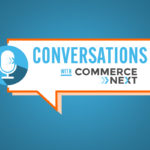Customer acquisition is expensive and, oftentimes, customers aren’t profitable until the second purchase. This begs the question: Are your best customers bought or made?
In our most recent episode of Conversations with CommerceNext, Co-Founder Veronikca Sonsev virtually sat down with Andreas Reiffen, Founder and CEO of Crealytics, to discuss how to use customer lifetime value (CLV) to acquire your best customers.
Read the recap below or watch the full episode here:
If you’re interested in learning more, register for the Marketing Summit Series. Reiffen will join Terri Westlake, Customer Director at Dunelm, to further break down whether your best customers are bought or made.
Episode Recap
Is it Time to Rethink Your Metrics?
Most companies use cost-per-order in the beginning, which is not the best KPI. Revenue-centric metrics like return on advertising spend or cost of sales are not as comprehensive. CLV is a more holistic measurement, allowing companies to invest their budgets in an effective way.
What Goes Into a CLV Calculation?
Using CLV accomplishes everything you need, predicting what a customer is likely to do over time without having much information about them. To calculate CLV, follow these steps:
- Pick a time frame, such as 12 months, 24 months, etc.
- Track the purchase of a first time customer: take the real product margin contained in their cart and deduct order related costs like shipping, packaging and payment.
- Repeat the same calculation for all repeat purchases within the determined time frame.
Reiffen warns against extending the time frame to many years, because the world can change quickly and so will consumer behavior and habits.
Second Purchase Misconceptions
The second purchase is highly idealized in the retail and ecommerce industries. When most companies calculate CLV, second time purchasers are viewed as much more valuable, which, in turn, influences brands to hyper-focus on driving that second purchase with all new customers. In reality, not all first time buyers are equally as likely to become repeat customers. For example, someone who is buying a gift is less likely to be converted into a repeat customer than someone who is buying for themselves.
Instead of overwhelming new customers with ads to drive retention, it’s a better use of resources to focus on getting the right people in the first place. What does this mean? To find the right customers, retailers and brands should:
- Use lookalikes or similar audiences on the social/display side. Give your current customer base CLV scores, extract the best and give them over to Facebook or Google services to target similar people.
- Use the ad system on the keyword search side. Model the projected CLV of the click and input that value back into the system to enhance the budgeting distribution.
Building Your CLV Model
To build a solid predictive CLV model, Reiffen recommends brands have:
- Solid margin tracking
- The ability to track new customers, which can be difficult for companies that have multiple businesses (e.g. online and in person)
- First order value
The biggest hurdle is internal education. Organizations need to be ready and prepared to break from their old KPI sets, make the CLV model a priority and have someone drive this process.
Best Practices for Improving Retention
Ads alone will not convert a customer. Companies should think about the value proposition that they can offer to a customer, such as the right product market fit, pricing and customer service. By gaining a strong understanding of who your customer is and tailoring your offer to those specific customers, ads will be more effective because traffic will convert.
Register for the Marketing Summit Series to hear Reiffen, joined by Terri Westlake, Customer Director at Dunelm, to dive deeper into the discussion of whether your best customers are bought or made.
Related Posts
-
Conversations With CommerceNext: CEO Perspective on Consumer Behavior in the New Normal
CommerceNext is excited to share the first episode of our…
-
Conversations With CommerceNext: Why Loyalty and Retention are Broken and How to Re-Think Them
Businesses aren’t getting the ROI they should be from loyalty…
-
Investing In Customer Experience In The Next Normal
This unprecedented, digital-first holiday season is well underway. In response,…
-
Personalizing Your Full-Funnel Customer Acquisition Strategy
We all love a brand that makes us feel special.…
-
The Secret Behind Chewy’s Customer Acquisition Strategy
How customer service contributes to Chewy’s successful customer acquisition strategy.…
-
How to Use Customer Service to Grow Sales this Holiday
Support requests increase from customers by 65% during Black Friday/Cyber…






